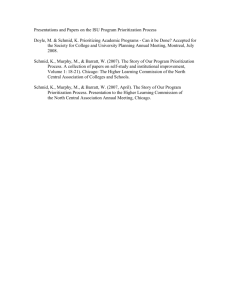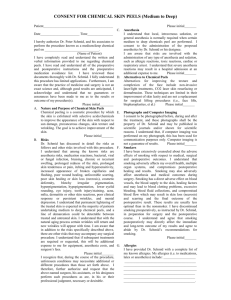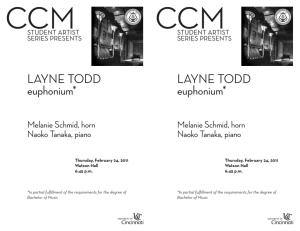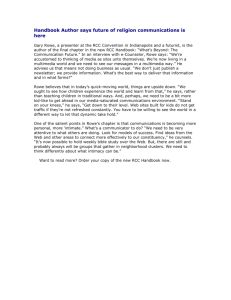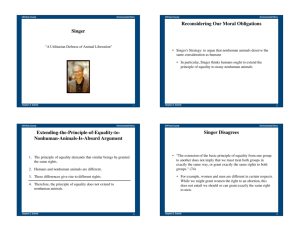Murder in the Desert: The Charles Schmid Case
advertisement
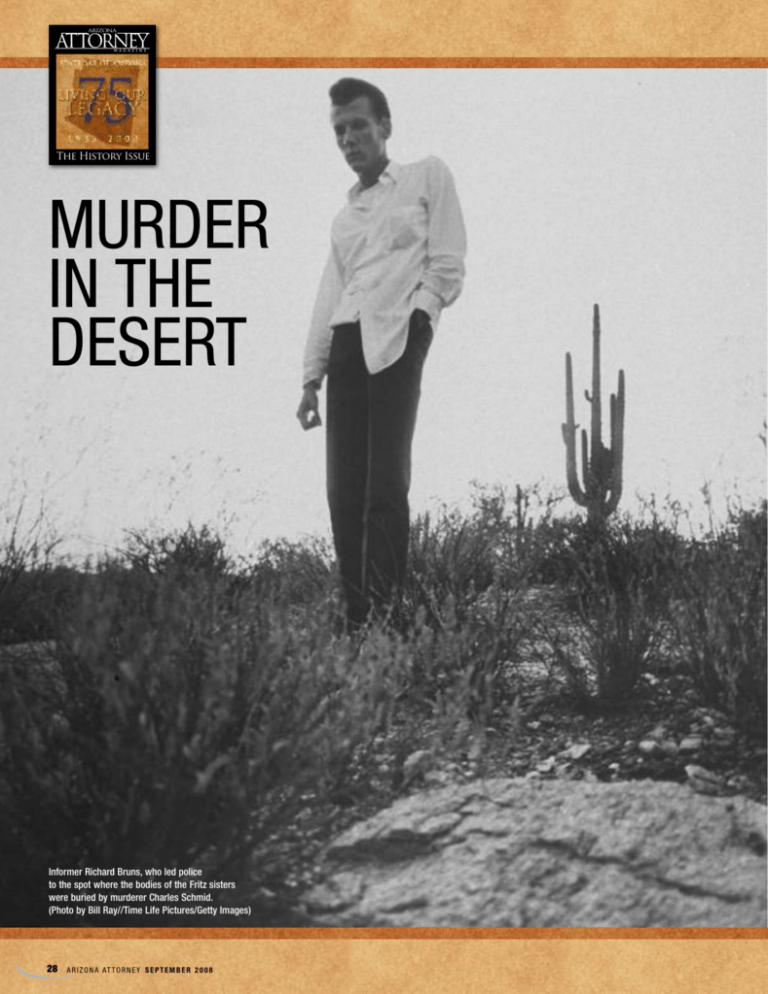
ARIZONA attorney M A G A Z I N E The History Issue MURDER IN THE DESERT Informer Richard Bruns, who led police to the spot where the bodies of the Fritz sisters were buried by murderer Charles Schmid. (Photo by Bill Ray//Time Life Pictures/Getty Images) 28 A R I Z O N A AT T O R N E Y S E P T E M B E R 2 0 0 8 BY HON. WILLIAM J. SCHAFER III Bill Schafer is a retired Superior Court Judge by way of New Jersey, Oberlin College, Case Western Reserve University, U.S. Department of Justice, Alaska, Pima County Attorney, and assistant Arizona Attorney General. It was while he was in the Pima County Attorney’s Office that he tried the Schmid case. Then, when he was in the Attorney General’s Office, he argued the case before the U.S. Supreme Court. In 1966, F. Lee Bailey came to Tucson to help a friend defend a man charged with killing three young girls and burying their bodies in the desert. Bailey didn’t stay for long; the trial in State v. Schmid was over almost before it began, and the high-flying lawyer left before the ink was dry on the convictions. The result he sought was not what he expected. The accused, Charles Schmid, was different from other young men. He was a good-looking man of 23, a high school gymnastics champion, very polite, impeccably mannered. He spoke well, and the mothers of his teenage friends liked him. He also dyed his hair, wore pancake makeup, put axle grease on his face for a beauty mark, wore a metal bridge on his nose pretending he had been injured, and at various times told his friends he had incurable cancer. He always carried tiny bottles of salt and pepper that, he told friends, he used to blind opponents. He stood 5 feet 3 inches, but with his boots on he was three inches taller. He was so conscious of his height that he stuffed rags, cans and cardboard in his boots to make him taller. As an infant, Schmid had been adopted, and his adopted mother gave him a house in Tucson, paid all of his bills, carried meals to him and gave him an allowance of $300 a month. He had no job. Some of his friends told him he looked like Elvis Presley, and he agreed. On Nov. 4, 1965, the Arizona Daily Star, Tucson’s morning newspaper, published an article headlined “Four Tucson Teenage Girls Have Disappeared Into Thin Air.” Police detectives, it said, “frankly admit they have no idea where they have gone. The mothers of all four girls fear foul play and two mothers insisted from the beginning that their daughters were dead.” “It has been more than a year,” the article continued, “since a pretty Palo Verde High School sophomore was last seen at her home. Alleen Rowe, 15, … has been missing since May 31, 1964. … Gretchen and Wendy Fritz, the teenage daughters of Dr. and Mrs. James M. Fritz … left home on Aug. 16 of this year. … Their car was found the next day.” A few days after that article appeared, the police received a phone call from a man named Richie Bruns. He told them he knew that three of the girls were dead, who killed them, and where the bodies were. He said a man named Charles Schmid killed Alleen Rowe. Then, to stop that murder from being exposed, he killed Gretchen and Wendy Fritz. Schmid’s girlfriend at the time was Mary French, a teenager who had dropped out of high school. Not many of the kids liked her; she was “a cold cookie, a dead fish,” they said. John Saunders was another Schmid friend, also a teenage high school dropout, a quiet, aloof kid On May 30, 1964, Schmid told Mary French that he wanted to kill a girl to see “if he could get away with it.” He had made a list of three possibilities, and he and Mary narrowed it down to one— Alleen Rowe. She was a pretty girl, likeable and quite intelligent. Mary called her and invited her to a party that night. She agreed, and about midnight they picked her up. She was in a bathing suit and a shift, with curlers in her hair. Schmid drove to a desolate area east of Tucson. While Mary waited in the car, Schmid and Saunders took off Alleen’s bathing suit. Schmid raped her and then grabbed a large rock and hit her on the head. She fell to the ground, unconscious. All three dug a hole and put Alleen’s body in it. Mary collected the dead girl’s curlers, which were scattered about, and put them in another hole. Two months after that Schmid met a pretty young blonde at a local swimming pool, and within weeks they were lovers. The girl was Gretchen Fritz, a teenage daughter of a Tucson heart surgeon. She had a younger sister named Wendy, who was 14. During the next few months, Schmid and Gretchen saw each other regularly. At one point Schmid told Gretchen that years ago he killed a boy, cut off his hands and buried him in the desert, and that he recorded it in a diary he kept. He also told her that he killed Alleen Rowe. S E P T E M B E R 2 0 0 8 A R I Z O N A AT T O R N E Y 29 ARIZONA attorney Murder in the Desert M A G A Z I N E The History Issue Charles H. Schmid Jr. at his preliminary hearing. (Photo by Bill Ray//Time Life Pictures/Getty Images) Soon, Gretchen became jealous of Schmid’s attention to other girls, and she told him that if he didn’t stop seeing them she would tell her father and the police about the boy he killed and about killing Alleen Rowe. To cement that threat, she stole his diary. On Aug. 16, 1965, Gretchen and Wendy went to a drive-in and never came home. Schmid had strangled them and buried them in the desert off Pontatoc Road in north Tucson. He was proud of it; he told Richard Bruns about it and even took him to see the Fritz bodies. He also took Bruns to the spot where he buried Alleen Rowe, but the body was still covered. Then, in November of 1965, Bruns got into trouble with the law. He was convicted of disorderly conduct and placed on probation for six months. The judge ordered him to spend the first three months with his grandmother in Ohio, but when he got there he couldn’t stand it. So he got in touch with the Tucson police and told them his story, knowing that that would get him back to Tucson. Bruns took the police to the desert off Pontatoc Road. There, strewn all over the desert, they found the remains of the Fritz sisters. But Bruns couldn’t find the spot where Alleen was buried. Murder charges for killing Alleen Rowe were filed immediately against Schmid, French and Saunders, even though the police couldn’t find her body. A second murder charge was filed against Schmid for the murders of the Fritz sisters. The prosecutor’s office offered a plea bargain to French and Saunders in exchange for their testimony against Schmid and for showing where Alleen’s body was. They both accepted. They took the police to where they had buried the body, but they couldn’t find it. All they could find were the curlers. Finding someone in the desert is no easy job. The prosecutors, the sheriff’s department, the police and a number of citizens never stopped searching, but we found nothing. Then one day I got a message saying that there was an old man in Mesa who could find things with his divining rod—a stick with a string and a little bone on the end. We brought him to Tucson and he searched and found a spot, but there was no body. The publicity surrounding the case was intense. Life magazine did a feature story. Playboy sent a reporter to cover the proceedings. It was covered by national television, international newspaAttorney William Tinney Jr., the defense lawyer for murderer Charles Schmid. (Photo by Bill Ray//Time Life Pictures/Getty Images) 30 A R I Z O N A AT T O R N E Y S E P T E M B E R 2 0 0 8 w w w . m y a z b a r. o r g ARIZONA attorney Murder in the Desert M A G A Z I N E The History Issue pers sent people to cover it, and everybody connected with the case was on the front pages for months. Because of this, Judge Richard Roylston entered a gag order muzzling all law enforcement agencies; they were not allowed to talk to the media about any aspect of the cases. That, of course, caused the press all over the country to boil; they said it was unconstitutional, and they threatened lawsuits. But the gag order remained intact. Mary French pleaded guilty to being an accessory and was sentenced to four to five years in prison. Saunders pleaded guilty to seconddegree murder and received a life sentence. Still, we could not find the body of Alleen Rowe, and I had to prepare to try a murder case against Schmid without the body of the victim. We wanted the Rowe trial to be held first. If he were convicted of the Rowe murder first we could, at the Fritz trial, show the murder of Rowe, and he could not dispute it because he had already been convicted. If, however, we had no conviction of the Rowe murder at the Fritz trial, Schmid could claim that he didn’t murder Rowe, and that would remove a motive for killing the Fritz sister. Schmid, of course, wanted the Fritz case to go first, and that is what the judge ordered. The trial for the Fritz murders began in February 1966. Mary French and Richard Bruns testified, but Saunders refused, asserting his Fifth Amendment rights. Schmid did not testify, and the jury convicted him of both murders. He was sentenced to death on each. The publicity surrounding the case was intense. Life magazine did a feature story. Playboy sent a reporter to cover the proceedings. Everybody connected with the case was on the front pages for months. Schmid and his lawyer William Tinney Jr. at the preliminary hearing. (Photo by Bill Ray//Time Life Pictures/Getty Images) 32 A R I Z O N A AT T O R N E Y S E P T E M B E R 2 0 0 8 ARIZONA attorney Murder in the Desert M A G A Z I N E The History Issue Schmid’s lawyer, Bill Tinney, then called his old Marine buddy F. Lee Bailey. Schmid had told the press that he wanted a different attorney for the Rowe trial. His first choice was Percy Foreman, a prominent defense attorney at the time, but Foreman said he was too busy and he suggested F. Lee Bailey, telling Schmid, “He’s a young man, probably the second best attorney in the country, very aggressive.” Bailey agreed to be co-counsel to Bill Tinney, and Schmid was pleased with that. He told the press “Mr. Bailey told me, ‘Charlie, I don’t know whether you’ll be out of here next summer or 11 years from now, but you’ll be out.’” After a number of delays, the Rowe trial began in May 1967. At its outset Bailey asked the judge to prevent the jury from considering a sentence of death because the body of the victim had not been found. He then asked that the state be barred from offering evidence of another murder, the murders of the Fritz sisters. Finally, he argued that the court had no jurisdiction to try “a man who is, under the law as I read it, already legally dead.” The judge thought that was an interesting point (so did I), but he denied the motion and all the other ones. Bailey did a masterful job of questioning jurors about their ability to be fair. He asked if any of them thought Schmid was guilty because he was represented by Bailey. None of them answered yes. Then he emphasized the fact that there was no body. He told them it would not do if they believed the victim was probably dead. He said, “We don’t use probabilities; so long as there is a possibility that the alleged victim might turn up somewhere would you be inclined to vote for the death penalty— or hold up?” Weeks before that, I had called a number of other lawyers to find out what Bailey was like in court, and one of them told me an interesting story. It was about a murder case of a young girl whose body was never found. When the defense attorney gave his closing argument to the jury, he harped on the fact that there was no body and asked the jurors if they could convict someone knowing that the victim might not be dead. Then he turned quickly toward the courtroom door, pointed and shouted, “There she is now.” Everyone in the courtroom turned toward the door. There was nobody there, of course, and the attorney looked at the jurors and said, “See, not even you believe she’s dead.” But the prosecutor was unmoved, and when he got up to make his rebuttal argument he said just one thing to the jury, “Everybody in the courtroom looked toward the door except for one person—the defendant—because he knows she’s dead.” I put that in my trial notebook, just in case. The defense declined to make an opening statement, and the state called its first witness, Alleen’s mother. Bailey asked her no questions. Mary French was the next witness. Once again she told the story of the murder. Bailey’s cross-examination was short, only about 20 minutes, and right to his points: that Mary hated Alleen Rowe and that she was more than a mere stand-by at the murder; that she was one of the instigators; and that she initially lied about 34 A R I Z O N A AT T O R N E Y S E P T E M B E R 2 0 0 8 Schmid’s involvement because he refused to marry her when she told him she was pregnant. Then Bailey stopped. “That’s all,” he said, and sat down. I called John Saunders, but he again claimed his Fifth Amendment rights. I then asked the court to allow me to read to the jury the transcript of the testimony Saunders gave at a preliminary hearing in the Rowe proceedings before he claimed his Fifth Amendment rights. The court granted my request and took the morning recess. After the recess, to the surprise of just about everyone in the courtroom, Bailey announced that Schmid would plead guilty to murder in the second degree, if the state would agree. I did, and Schmid pleaded guilty and admitted in open court that he killed Alleen Rowe. As Bailey was leaving the courtroom that day, he leaned toward me and said, “You know there’s another one out there, don’t you?” I nodded, sure that he meant the boy with no hands. But no such body has ever been found. Within a few days, Schmid claimed he was innocent and filed a motion to fire Bailey and Tinney and to withdraw his plea of guilty. With that, his attorneys called it quits, and the judge would not let Schmid withdraw his plea. He was sentenced to 50 years to life. Then a very curious thing happened. A month or so later, Schmid told the sheriff he would take him to the body of Alleen Rowe. The sheriff called me and asked if it could be done. I said yes. When the caravan of sheriff’s vehicles reached Harrison Road on the eastern outskirts of Tucson, Schmid had them stop the car near where French and Saunders had taken the police months before. After getting oriented, Schmid took them to where he had reburied the body—neither French nor Saunders could find it because Schmid had moved it. The sheriff’s men started digging. Schmid also dug, with his hands in handcuffs. He was anxious to show everyone, he said, that Ms. Rowe’s skull was not fractured and that he was innocent. A foot below the surface, they found the body. As Schmid helped clear the dirt around the skull, he told the coroner, who was also digging, that when they got the skull everyone would see there was no fracture. But he was wrong; there was a fracture, a very large one, consistent with being hit by a large rock. And curiously enough, the body was found just 20 yards from where the old man diviner had taken the investigators. In time, the Arizona Supreme Court affirmed Schmid’s convictions and the two death sentences for killing the Fritz sisters, and the Court of Appeals affirmed his conviction and his sentence of 50 years for killing Alleen Rowe. Schmid sent me a letter after that telling me what a good job I had done, and he asked me to be his lawyer for his later appeals. The next year I was elected Pima County Attorney, and he sent me a letter of congratulation. A year after that he was killed at the state prison by two inmates. But I doubt that his story will ever die. AZ AT w w w . m y a z b a r. o r g
